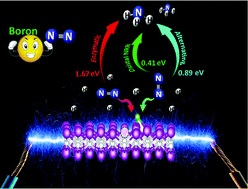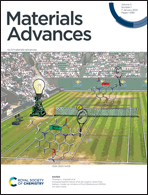Electrocatalytic nitrogen reduction directed through the p-band center of boron on BSAC@Mo2C†
Abstract
Greener modes of ammonia synthesis via the electrocatalytic route have been investigated on pristine and defective Mo2C based monolayers anchored with metal-free boron atom catalysts. Boron single atom catalysts (SACs) on the defective Mo2C monolayer has been found to activate N2 strongly with an adsorption energy of −1.92 eV and reduce it to NH3 efficiently with a significantly low overpotential of 0.41 eV. The exothermic adsorption of N2 and low overpotential for the nitrogen reduction reduction (NRR) appertain to the p-band center of the boron atom catalyst and charge transfer between the adsorbed N2 and the catalyst, respectively. This work brings forth the correlation between electron occupancy on the boron center and NRR catalytic efficiency on a metal-free SACs@Mo2C monolayer couple, thereby serving as a lead in designing metal free electrocatalysts for the NRR.



 Please wait while we load your content...
Please wait while we load your content...